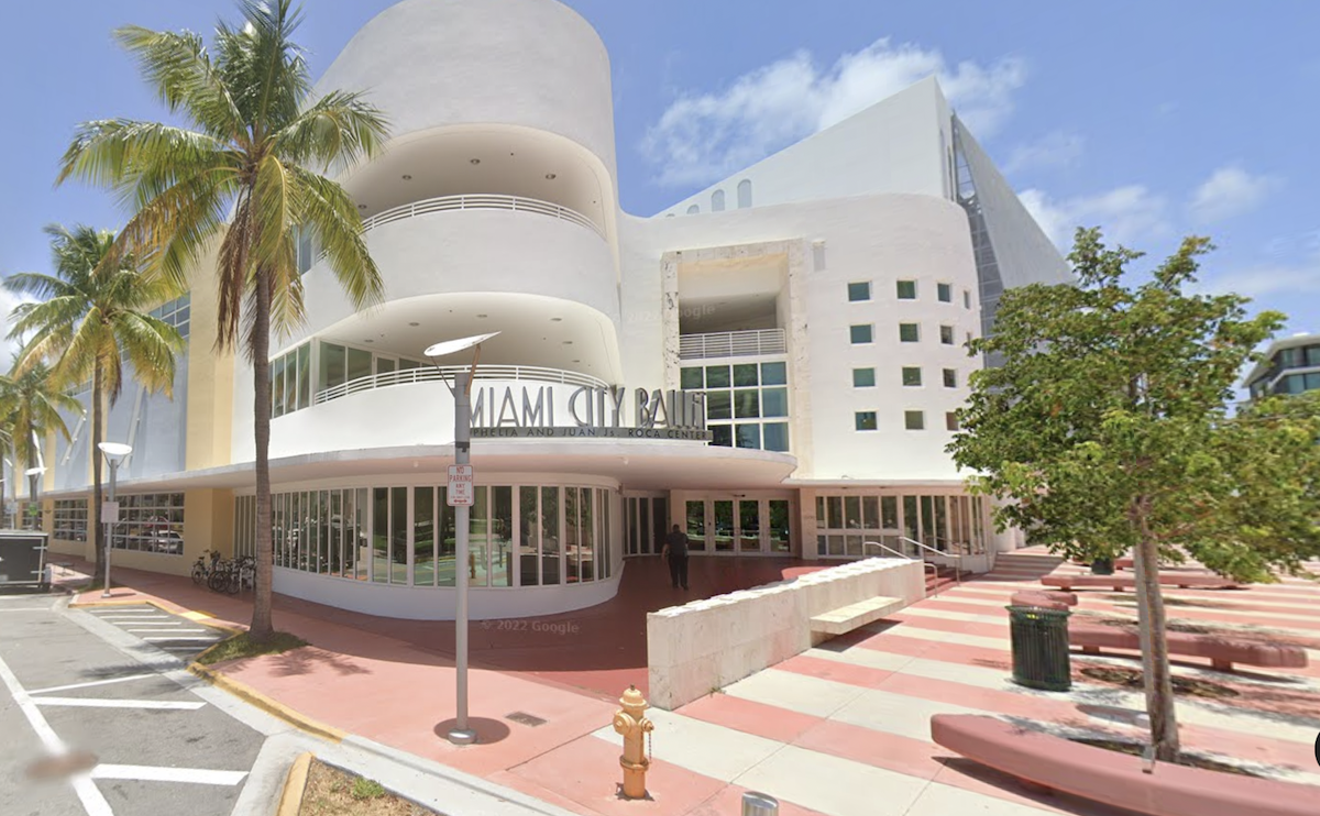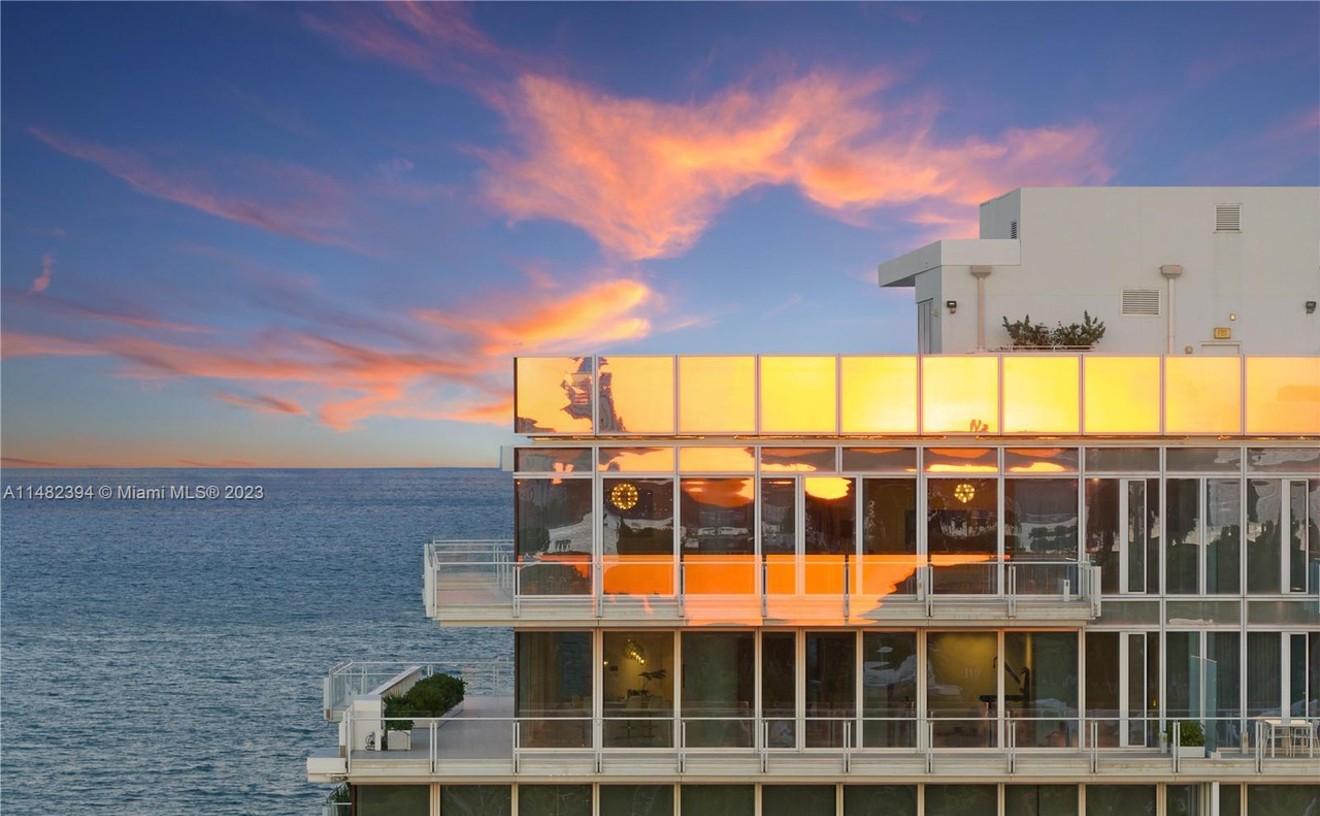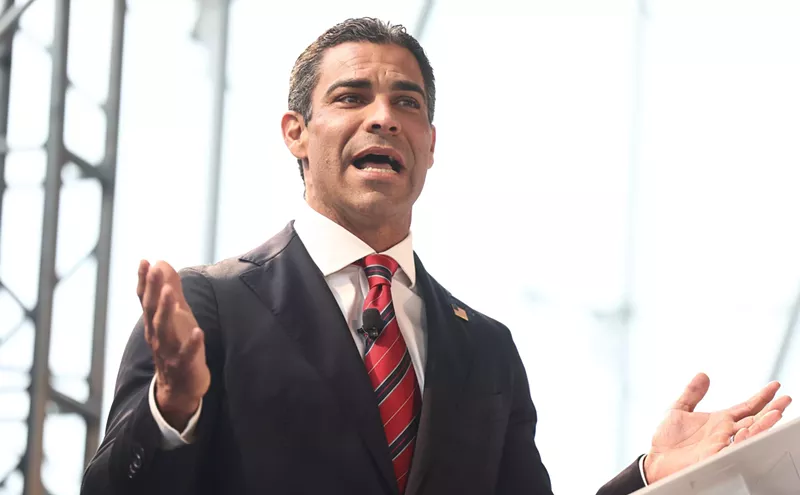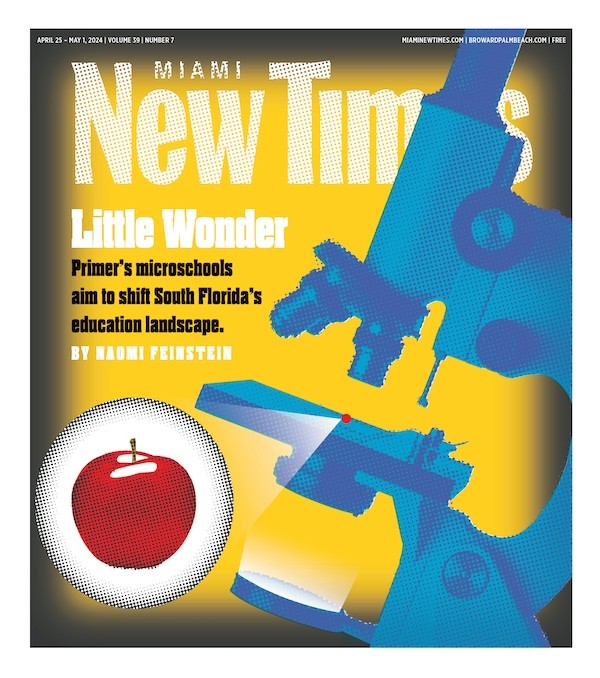When Jay Miscovich stepped off Duval Street into the Bull & Whistle bar in January 2010, Key West was shivering through a cold spell, the thermometer parked at a rare 70 degrees. A bearish guy in his 50s with a beach-ball gut and an ever-present baseball cap pulled over his bald head, he crossed the stone floor, extending a hand to an old acquaintance.
The room was nearly empty. Afternoon shadows mossed the high ceilings. Steer horns poked from the corners. The walls surrounding the U-shaped bar were splashed with fading murals of Florida legends, yellowed like old photos: a beer-bloated Hemingway; railroad baron Henry Flagler; and next to a pair of regal galleons, Mel Fisher, the famous treasure hunter.
Even though Miscovich hadn't seen him in over a decade, Mike Cunningham looked the same. A drifter, he was tanned and whittled thin from day labor. A clean white sweatshirt hung off his shoulders.
"How's it going?" Miscovich asked, his consonants sloshing around in a wet lisp. When he'd known Cunningham years earlier, back in their hometown of Latrobe, the handyman had been painfully shy, preferring to mow grass or paint walls alone. Back then, Miscovich hired him regularly, and Cunningham still checked in a few times a year after moving to Florida for year-round work. Knowing that his former employer had an interest in treasure hunting, he'd asked to meet today.
Cunningham pulled out a worn plastic bag holding a brown piece of pottery. From the cracked glaze, Miscovich guessed the piece could be Spanish colonial — valuable.
Cunningham next unfolded a piece of paper — a photocopy of a nautical chart. No GPS coordinates. Handwritten on the paper was an X, the words "pirate wreck," and rough drawings of cannon. Cunningham explained he'd found the pottery while diving in the Gulf of Mexico with friends.
"Do you think you'd give me $500 for it?" Cunningham asked. The pottery alone sold Miscovich. But the chart also lit his interest. If there were more pottery at the site, $500 wouldn't be a bad investment.
After the money changed hands, Cunningham left. Miscovich drank two more beers alone, silently toasting the possibilities.
It wasn't until Miscovich was on the stand in a federal trial that he publicly served up this story — of how he, a broke no-name from Pennsylvania, had stumbled into a potential multimillion-dollar treasure find. By then — almost three years after hitting the jackpot — he was probably Key West's most hated figure.
To Conchs, it was unbelievable that this stranger could have lucked into a jackpot that had eluded hundreds of other divers for decades. Key West's treasure-hunting community smelled a fraud, and Miscovich's far-fetched tale about treasure maps in bars seemed proof-positive.
But it was undeniable that Miscovich now had bags and bags of little green rocks. Were they really priceless or just costume junk barely worth their weight in rhinestones? And most mysteriously of all, where had they come from?
One entity would be particularly interested in digging up the truth: the world's most powerful treasure-hunting family.
Black or shiny. The two words were on replay in Steve Elchlepp's mind as he breathed through his regulator and scanned the bottom of the Gulf of Mexico about an hour's boat ride from Key West. Black or shiny.
Through the shifting water, the muscular dive instructor could make out Miscovich, wrapped in a black wetsuit, waving a metal detector over the sand. Here, 50 feet below the surface, mixed-up currents created fun-house tricks of perspective, the visibility collapsing and expanding and collapsing again. Blankets of blues and grays billowed like laundry on a clothesline in a windstorm. Black or shiny.
To stay oriented, Elchlepp kept his eye on the floor, on alert for silver (which, after hundreds of years in salt water, turns black from oxidation) or gold (which never loses its shine). Black or shiny.
Fifteen feet away, Miscovich was waiting for a ping from the metal detector patched into his mask. After following the map's lead, the pair had scanned the ocean floor for two days with a sensor dragging behind their boat but hadn't picked up any signals. Today, day three, they expanded their scan area, finally picking up traces of metal. But each trip below yielded nothing. Miscovich was getting frustrated. So far, all he had found were some Bud Light cans, and this was their last dive of the afternoon.
Like any experienced diver, Elchlepp periodically checked on his friend. On one of those glances, he saw Miscovich jabbing his finger toward the surface, signaling his partner topside. He'd found something.
Bobbing near the anchored boat, Miscovich showed what was cupped in his hand: quarter-sized chips of green rocks.
"I think those are frickin' emeralds," Miscovich told his partner. "Steve, there's thousands of them down there."
Back down on the bottom, Elchlepp focused. He could pick out small shapes scattered in the sand. As he changed the angle of his head, the pieces shot off faint glimmers like small match strikes. Shiny.
Miscovich tried to leash his enthusiasm as they packed empty sandwich bags with handfuls of green stones. Green? Check. Glassy? Yes. Then he noticed that the stones he was picking up also had hexagonal sides, a giveaway for precious gems. Pretty soon, the treasure hunter was ecstatic. If these had leaked from the side of a shipwreck — especially an ancient colonial ship — he was about to ride an emerald boom into a new tax bracket.
Black fists of cloud blocked off the sun. The wind shredded the water's surface into whitecaps and 15-foot waves. With its three masts snapped and rudder in pieces, the Nuestra Señora de Atocha was relentlessly knocked around by the hurricane blasting in from the northwest. Screams of the ship's 265 passengers and crew were soundless against the raging weather.
Only two days earlier, the 20-cannon Spanish galleon had sailed from Havana, part of a 28-ship fleet aimed at Seville. The cargo hold was stuffed with precious treasure, the fuel to keep King Philip IV marching across Europe. Now, on September 6, 1622, the wind shoved the galleon above the waves, spiking the keel against a nearby coral reef.
The galleon was quickly gone, sealed away under the water near the Dry Tortugas. As the centuries flipped by, thousands of others would join it, the victims of coral reefs, pirates, and tricky weather. Rumors of riches onboard kept the ships' names alive. When modern scuba equipment made retrieval possible in the 1950s, adventurers went looking. A treasure salvage industry was born.
In the 1960s Key West became a holding pen for people drawn to the hunt, from adrenaline junkies to criminal types smelling quick money. Salvage presented the ultimate challenge: the hunter pitted opposite his competitors, nature, and even the big obliterating hole of history itself. The stakes didn't lend themselves to subtleties; treasure hunters became known for smashing natural habitats and historic ships, providing constant headaches for environmentalists and archaeologists.
A charismatic California chicken farmer moved to Key West in the 1970s with treasure on his mind. The Atocha was his target. Running on a threadbare budget, Mel Fisher spent a decade looking for the ship, every day repeating his trademark mantra: "Today is the day." Occasionally the diver would unearth traces of a wreck — silver coins, gold bars, cannon — and despite seeing his son and daughter-in-law killed in a boating accident while searching, Fisher hung in. In 1985, his team discovered a significant stash from the Atocha's hold — 127,000 silver coins, 900 silver bars, and 250 pounds of gold. The estimated value: $400 million. Fisher became a worldwide celebrity thanks to TV specials and National Geographic spreads.
But as much as the Fisher find embodied every treasure hunter's hope, it also set the tone for the future. First, Fisher had to legally arm-wrestle the State of Florida for ownership, then drum up investors to execute the expensive salvage operation. He also stretched fact into fiction: While on his deathbed in 1998, Fisher admitted to selling counterfeit coins in his gift shop.
Today's salvage industry still attracts an outlaw element looking to cash in on the old magic, but the process has been sanitized by protocols. Contested claims that once might have been settled with barroom punches are now fought by lawyers. When a treasure hunter makes a valuable discovery, he is now required to file an admiralty action in U.S. federal court. This process opens a window for competitors — other salvage outfits or foreign governments — to argue that they have a right to the goods.
Even if a treasure hunter is granted title, excavations often require millions. The largest player in the game, Tampa-based Odyssey Marine Exploration, is a corporation traded on the NASDAQ. Even the remnants of Mel Fisher's operation — today called Motivation Inc. and run by his son, Kim — are dependent on investors.
Although salvagers in Key West continue to pick over old shipwrecks and pull out small finds, there hasn't been a major discovery in 30 years.
That is, until Miscovich and Elchlepp began pulling green stones from the sea.
Miscovich was born in Latrobe, Pennsylvania, a small town west of Pittsburgh best known for Rolling Rock beer. His mother was a teacher; his father worked in a steel mill.
As a kid, Miscovich bought baseball-card packs in bulk to find a single Roberto Clemente card. He'd stop at stores all over town, cashing pocket change for old pennies, fingers crossed for rare coins from the 1920s.
At 17, his collecting impulse was rerouted into real estate. Miscovich used cash from caddying to buy a dilapidated five-unit rental. His parents cosigned. After slapping on some improvements, he flipped the building, pocketing enough profit for a new Trans-Am.
He earned a bachelor of science degree from St. Vincent College, then went to medical school at the American University of the Caribbean in St. Maarten, graduating in 1984. But Miscovich never practiced medicine. More money was waiting in real estate.
"From the time I was in my early 20s to 2009, I was a millionaire on paper," he says now, estimating that he did about 400 deals around the Latrobe area.
Still a bachelor in the late '90s, Miscovich hung around VFW lodges and became a volunteer firefighter. Another social outlet was a local scuba club. He joined but didn't find much of interest on the bottom of local lakes. Scuba friends told him about diving shipwrecks. The idea of undiscovered historical finds littering the ocean floor was enough to hook his imagination.
Soon, he decided to put money into treasure salvage. For his first investment, he was sweet-talked into fronting $25,000 for a dive outfit in West Palm Beach, only to find out the divers never even took the boat out. Instead of abandoning the pursuit, he decided to invest with other, reputable outfits, including Mel Fisher's Motivation Inc.
Sometimes his investments paid off in real treasure. Folks in Latrobe went wide-eyed when Miscovich brought out Spanish coins or jade fish carvings from his desk drawer.
"I always thought Jay was sort of in a parallel universe," says Dave Sarnovsky, a friend and business partner. "Most people don't have thousand-year-old treasure in their house. I was afraid to touch it."
His family was less dazzled.
"He was making all his money in real estate, and he was putting hundreds of thousands of dollars into [treasure hunting] every year," says Miscovich's brother Scott, a successful pediatrician in Hawaii. "I thought it was foolish."
Miscovich didn't save much. Because most of his money was tied up in property, his wealth roller-coastered with the whims of the market. Over the years, he got sued over deals gone bad. The 2009 downturn finished him off completely.
Then 49, Miscovich had seven houses waiting for buyers when lending flatlined. He couldn't cover what he already owed. The debt stacked up. Banks started stuffing his mailbox with foreclosure slips. Eventually he'd owe more than $600,000.
"It became obvious afterwards that he was taking from Peter to pay Paul. I was the Peter in this case," says Dwayne Ross, a Latrobe attorney who flipped a number of houses with Miscovich in the late 2000s before a final deal went sour. "I have a $19,000 judgment against him that still hasn't been satisfied."
Suddenly Miscovich, the longtime "millionaire," was crashing at a friend's house, hawking his own refrigerator to cover bills, and accepting handouts from family. He couldn't go into medicine — renewing his license now would take too much time and money. Even Home Depot shot down his job application. "It was the lowest moment of my life," Miscovich says today.
Down so far, any shot out looked good. His head started percolating with the idea of going all in on treasure hunting. Even if he didn't find a life-changing shipwreck, he could live off simple salvage work.
By December 2009, he packed up for Key West. Right away, he teamed up with Steve Elchlepp, an acquaintance from a previous dive investment. The two clicked. The younger man in his 30s — a quiet Navy vet with a life-sized G.I. Joe build — had crammed his shaved head with the technical aspects of diving. He too had dabbled in treasure hunting, but so far, his ventures had turned into headaches.
"When I first met [Miscovich], we talked about how neat it would be to be involved in a company that would be established and looked up to," Elchlepp recalls. "We were so tired of hearing the professional communities bashing treasure hunters because they're known as smash-and-grab guys. We wanted to change that."
Technically, Miscovich was the boss, Elchlepp his project manager, but complete trust united the pair. When the Pennsylvania native, just one month after moving to Florida, walked into the shambling one-story dive house they shared waving a treasure map and a story about a drifter in a bar, Elchlepp had no reason not to believe him.
Thrill turned into concern as Miscovich and Elchlepp motored back to Key West on the day of the find. It was surreal — scary even. With the winning lotto ticket in their pocket, who could they trust?
They swapped oaths of silence. Over the next four weeks, anyone watching would have seen the men buzzing out at dawn in Elchlepp's 25-foot Grady White, fishing poles clanking in the cabin. After daylight had leaked from the sky, they'd be back in Key West, fishless.
Miscovich and Elchlepp were instead returning with thousands of stones. Each night, the pair cleaned salt and sand from the gems with toothbrushes. Over the course of about 70 trips to the site, with two- or three-hour-long dives for each trip, they pulled out 150 pounds, piece by piece, by hand. More always waited on the bottom.
The pair also scanned the internet for information on the gems' provenance. Emeralds come from Colombia. During the colonial era, the Spanish had pulled their share from the Muzo mines. It was logical that emeralds may have scattered from a ship lost between the colonies and Europe. Cue the ringing cash registers.
But the pair did not come across a shipwreck. They did find debris — cannon balls that must have come from an older ship, metal piping that obviously had sunk from a modern craft. Alone, the pair couldn't really determine what was out there. To properly excavate the site, they'd need financial backing.
"If you make a trip a day, you're using up about $1,000 a day basically," Miscovich says. "Fuel is about $600 because you're running the generators constantly. Then food, water, air tanks, oil. We probably needed $250,000 to $500,000 to work this whole claim."
Miscovich dialed up his brother Scott in Hawaii and told him about the emeralds, though he held back on specifics. Scott was skeptical.
"He was almost cautious to the point of being paranoid about who would know what about the location," Scott says today. "At first, I didn't understand it. But I think after a while, we were worried about his security if word started to leak out. The only difference between some of the people that are actively involved in the treasure-hunting industry and the pirates of 200 years ago is 200 years."
Scott introduced his brother to deep-pocketed investors in New York City who might be interested in financing a unique investment with high return. These moneymen, wanting to assess the risks, demanded to know how Miscovich had found the emeralds. He told them about Cunningham — who presented a problem. If the drifter reemerged, he could put up a legal challenge.
Miscovich unrolled the same Cunningham story that would later sound unbelievable on the witness stand. He claimed he didn't have any way to contact the drifter; he had always called from different numbers, and Miscovich didn't know where he lived. The investors said if Cunningham ever showed up again, offer him $50,000 for his release on the claim.
In April, Miscovich's phone rang. Cunningham was going to be visiting Latrobe soon. Miscovich — who was then bouncing among Key West, Latrobe, and New York — arranged to meet and got a contract drawn up, just in case.
At a local bar, Miscovich told Cunningham he'd found some valuables — but didn't specify thousands of emeralds — near but not at the exact spot that had been marked on Cunningham's treasure map.
Miscovich says Cunningham was happy to take cash rather than get involved in a legal mess. A notary came to the bar and witnessed Cunningham sign the contract and accept cash. Then, Cunningham disappeared — completely. Later, no one would be able to find him. He couldn't be reached by phone and didn't have a Facebook page, and mutual friends didn't know where he might have gone. This is the part of Miscovich's story that's hardest to swallow, even among his supporters.
Court records show that by September 2010, the Miscovich brothers, Elchlepp, and eight other investors formed a company called Emerald Reef LLC to salvage the site. Elchlepp stayed in Key West, dangerously diving alone, each time handing his girlfriend a sealed envelope with the GPS coordinates, in case he didn't return. His partner took meetings in Manhattan — sessions with lawyers, marketers, moneymen, and gem experts.
Around this time, Miscovich walked into the New York office of Josh Lents, an expert with the Gemological Appraisal Laboratory. "He started pulling these specimens out one by one," the expert recalls. "Before I knew it, my entire desk was fully covered by these green rough emeralds. It took me a little while to actually realize what was in front of me." When Miscovich asked Lents about how much a few of the pieces could fetch, the expert couldn't answer. He wasn't sure comparable specimens existed in the world. Initial spectroscopic tests showed the stones were in fact emeralds, probably from Colombia. But the pieces were so rare — large chunks, colored a deep green, sprinkled with valuable pyrite — that Miscovich might be able to ask whatever he wanted.
Carats aside, what really spikes the price of precious gems are their backstories. One sample emerald was appraised at $25,000 by a New York City lab, but Sotheby's valued the same rock at $40,000. Another appraisal said 25 of the pieces could fetch more than $100,000 each. But if Miscovich had proof these had come from a famous shipwreck, the price could easily quadruple.
As long as he could get the admiralty title and secure the rights to the emeralds, Miscovich's haul could fetch a few million dollars — or a few hundred million.
But the arrangement with investors soured by late 2010. Elchlepp and the Miscoviches say the moneymen tried to yank away control. The investors charged Miscovich and Elchlepp with stashing emeralds in Pennsylvania and Key West after agreeing all the treasure would reside in a New York bank. A lawsuit was filed in Delaware, freezing the money flow.
The legal action made the find a matter of public record and tipped off the treasure community. In October 2011, the Key West Citizen ran an article announcing that a half-billion dollars in emeralds had been found 30 miles off the island. Attention fixed on Miscovich and Elchlepp, jacking up their paranoia. On internet messageboards devoted to treasure hunting (like treasurenet.com and investorshub.com), posters questioned the emeralds' authenticity and referred to Miscovich as "Scrooge Mc Duck" and the "300lb plus diver."
The pair became convinced they were being followed. Elchlepp called the police after spotting prowlers across the channel from the dive house. A CBS News crew turned up at Miscovich's Latrobe address.
By September 2011, the investors settled with the treasure hunters. Per a court order, details of the settlement are confidential, and neither side would discuss them for this article. Miscovich, with his partners, filed an admiralty action under their newly formed company, JTR Enterprises, that October, then waited, anxious Spain would intervene.
Instead, Mel Fisher's family filed a competing claim on the emeralds.
Manuel Marcial slowly picked through the milky-green stones poured out on the white linen cloth, occasionally purring approval. An elderly jeweler with a chin frosted by a dapper goatee, he sidelined a handful of promising pieces, next examining each between his fingers. On August 14, 2012, after about five hours and 80 bags of green rocks, the jeweler stepped into the office hallway filled with lawyers.
Emeralds were big business for the Fishers. Nearly 30 years after first excavating the Atocha site, Motivation claimed emeralds were still hidden below the waves. Every year, the outfit splashed promotional material with declarations that 70 pounds of the precious stones were still missing from the ship. To help fund the search, they solicited investors.
The treasure-hunting royalty dug in for a legal fight against the upstarts, but the court battle was never supposed to be about the emeralds' value. An admiralty claim is only supposed to determine who owns the find — whether said find is priceless jewels or worthless junk. But the selling price of Miscovich's find became the hot topic in court.
The legal battle became Key West's story of the decade, with fact and fiction wrestling for the spotlight.
First, the Fishers claimed that the 1622 hurricane that bashed the Atocha could have pried a barrel of emeralds loose from the ship, carried the cargo 30 miles northwest, and then smashed it near the Miscovich site, even though the actual coordinates were still a secret. Because the court had granted Mel Fisher and his heirs exclusive claims on the Atocha treasure, Motivation argued the emeralds were theirs. (Through their attorney, Hugh Morgan, the Fishers declined to comment for this article.) They wanted their emerald expert, Marcial, to inspect the material to ascertain whether it could have been from the ship.
But their claim was shoddy. Experts countered that debris from the Atocha had spilled in the opposite direction — southwest, not northwest.
In July 2012, the Fishers pulled out a new theory: Miscovich and Elchlepp had conspired with a former Fisher diver to steal emeralds from the Atocha site and later plant the stones in the new location, they said. Once again, they petitioned the court to have Marcial inspect the stones.
As the Fishers scrambled to put together a plausible theory for their ownership of the emeralds, Miscovich's own story was taking on water. A television crew from 60 Minutes sent emerald samples to European labs for independent appraisal. Bad news: The European lab found a possible epoxy, suggesting the emeralds had been treated in modern times.
That stunned even the Miscoviches. "That was a big setback for me," Scott Miscovich admits. "Everyone is thinking Spanish, and we're doing research on ships." But the epoxy suggested there was no way the emeralds could have come from a colonial-era ship. "The question is: When were they lost in the ocean? [The epoxy] changes your timeline probably to a more contemporary time."
As Miscovich would tell the court, tell 60 Minutes, and maintains to this day — he never claimed to know where the emeralds came from. He only found them.
"None of us were there when the find occurred except Jay and Steve," Scott says. "They were put on the rack, for weeks and weeks, and challenged on different points: how, when, where. That's all we had to rely on. And they were very consistent."
In August 2012, Marcial was allowed to examine the rocks in a Key West law office. At the end of the appraisal, Marcial announced the stones were not from the Atocha.
"I was shocked," Miscovich recalls. "I was absolutely sure they were going to say they were from the Atocha after everything we had been through."
Marcial valued the entire lot at less than $50,000. He suggested the stones couldn't have been underwater for more than a few months.
"In all my 56 years in the emerald business, I have not seen emeralds of such poor quality as the rough alluvial emerald beryl material present," the jeweler wrote in his official appraisal. "These largest groupings of rough would be more appropriately described by the Colombian term 'barro' which roughly translates as 'not worth sweeping off the floor.'"
The Fishers let go of their admiralty claim on the stones — but filed a motion for sanctions against Miscovich and Elchlepp. They accused the men of planting discount-bin rocks on the bottom of the ocean so they could con money from investors. This summer, both sides will be back in Judge Lawrence King's court for a sanctions hearing. If Motivation Inc. can prove Miscovich committed fraud, he could have to pay the company's legal fees.
Miscovich's lawyers shot back. Motivation was the fraud, they said, luring investors to the Atocha with the promise of missing emeralds — when in fact, emeralds were never listed on the ship's manifest. An expert questioned whether 70 pounds of emeralds could even have come from the Spanish emerald mines in the New World in 1622.
By then, however, the treasure-hunting community had sided with its first family. Online, users of treasure messageboards relentlessly taunted the landlocked Miscovich, saying he must have bought a bag of rocks from the Tucson gem show and dumped them overboard or teasing him that other boats were out at his unprotected site, scooping the last green rocks out of the sand.
The judge's ruling on the admiralty claim came on January 25, a Friday afternoon. Because there was no shipwreck on the emerald site, "There is just as much support for the theory that Jay and Steve planted the stones as there is for the assertion that they found them," King's judgment stated. "The Court cannot simply accept the un-contradicted testimony of Jay and Steve that they followed a treasure map to the site, dove the floor, and found the emeralds."
Miscovich could go home with his emeralds but without the title that would award him the rights to any treasure found at the site. Without it, investors are unlikely to fund any salvage ventures.
"He basically said in his ruling that this was a scam," Kim Fisher told the Key West Citizen after the ruling, perhaps reading too much into the decision. "We've spent a lot of time and money on this case in an effort to protect the integrity of the legitimate treasure-hunting industry."
In February, the Fishers declared they had found Mike Cunningham. A follow-up in the Citizen spread the news, implying that Miscovich's fraud would soon be exposed.
The news didn't faze Miscovich. It was a different Mike Cunningham, he explained; there were two men with the same name in Latrobe. Sure enough, at a deposition in Pennsylvania, the woman who notarized the $50,000 agreement between Miscovich and Cunningham would testify that the individual located by Motivation's attorneys was not the man she'd met.
"The site is still unprotected," Miscovich says, "and I know there's still a fortune of emeralds out there. What if someone else goes out there and files a claim on the site?"
Today, Miscovich theorizes that the emeralds could have come from a wrecked World War II transport ship known to be lying in the area. Or drug runners or smugglers transporting the stones across the Gulf of Mexico may have dropped the load after spotting the Coast Guard.
Though the Fishers posed like heroes defending the treasure industry, Miscovich notes that by crucifying him, they torpedoed a competitor. Had Miscovich been granted title, investors who still dump money into the Atocha might have invested with Miscovich's company instead.
So if he knows the secret location that still harbors thousands of emeralds, why isn't he out there right now, scooping up what's left?
Money is the simple answer. Because he has no legal rights to the site and because the case has been widely publicized, someone else could move in on the find. "It would be very easy to follow us out there," he says. "Once that happens, there will be a hundred boats out there by next week."
Miscovich has personally transported the emeralds from Florida back to Latrobe, where they're sitting today. He plans on selling off stones to pay for more attorneys' hours. Right now, Miscovich is shopping his stones in Europe and Japan, where the market is hotter for emeralds.
He's also filed an appeal of the January decision. The claims he dumped stones on the sea floor and concocted the whole thing — ridiculous, he says. A fraud that size would cost money — money he doesn't have.
Josh Lents, the New York City gem expert who's logged the most hours examining the stones over the past three years, analyzing all 150 pounds, laughs off a $50,000 valuation. The stones have been subjected to a battery of long-term testing, including x-ray fluorescence and infrared examinations. Lents estimates Miscovich still stands to make $10 million to $20 million.
"The branding and marketing of the material will be the most crucial element in fetching these numbers," Lents says. "If they were to just simply liquidate everything by selling it all in one shot to the highest bidder, they will cut into their potential profits by millions. If they add in another variable by telling the story behind it, well, you have something entirely different."
Despite that potential payday, the treasure hunter says the whole ordeal hasn't been worth the trouble. He has a recurring fantasy: He calls up the news crews, loads up all 150 pounds of emeralds, then points a boat for the Cayman Trench, 8,000 feet deep and unreachable to humans. With the cameras rolling, he tips the whole lot overboard, watching as the black sea swallows the glittering stones.











